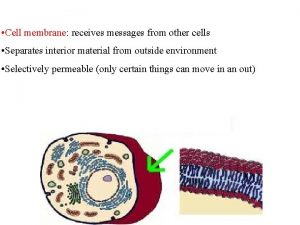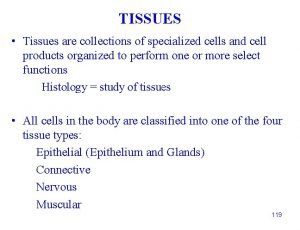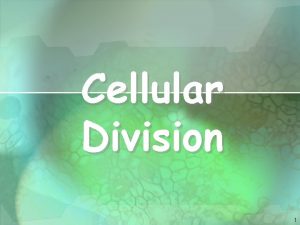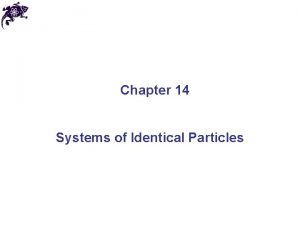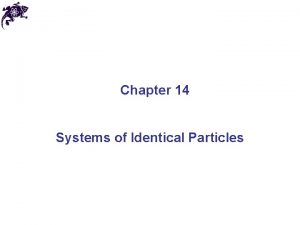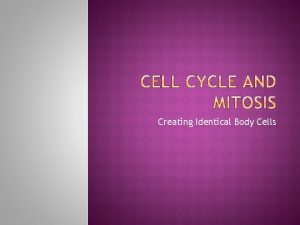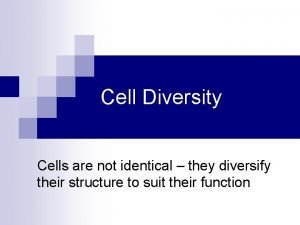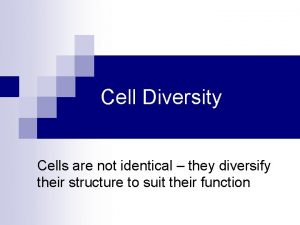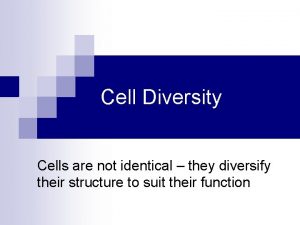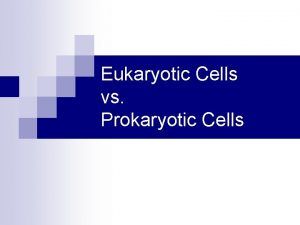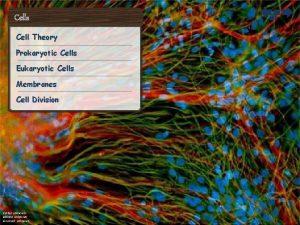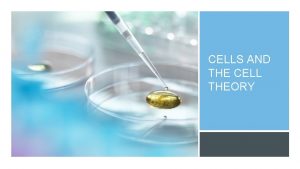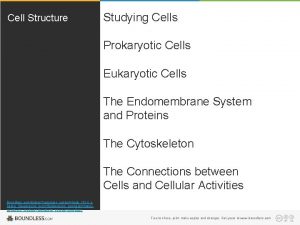Cell Growth Keeping Cells Identical The instructions for



























- Slides: 27

Cell Growth

Keeping Cells Identical • The instructions for making cell parts are encoded in the DNA • Each new cell must get a complete set of the DNA molecules 2

DNA Replication • DNA must be copied or replicated before cell division • Each new cell will then have an identical copy of the DNA Original DNA strand Two new, identical DNA strands 3

Cell Division • Process in which a cell divides to form 2 new daughter cells. • Before the cell divides it must copy its DNA (DNA is in the nucleus- only in eukaryotes). • 2 stages– Mitosis (division of the nucleus) – Cytokinesis (division of cytoplasm)

Where does this occur? • Mitosis occurs in the DNA in the nucleus. • DNA is found on chromosomes. • Each chromosome has 2 chromatids. • Each chromatid is attached by a centromere. Chromatid

Human Chromosomes • A picture of the chromosomes from a human cell • First 22 pairs are called autosomes • Last pair are the sex chromosomes • XX female or XY male 6

Cell Cycle • Series of events that a cell goes through as they grow and divide. • Consists of 4 phases– M phase (mitosis and cytokinesis) – G 1 (gap) phase (INTERPHASE) – G 2 (gap) phase (INTERPHASE) – S (synthesis) phase (INTERPHASE)

The Cell Cycle • • • Interphase Prophase Metaphase Anaphase Telophase S phase G 2 phase

DNA Copied Cells Mature Cells prepare for Division Cell Divides into Identical cells

Mitosis and Cytokinesis Cell grows and prepares for mitosis Spindle forming Centrioles Nuclear envelope Chromatin Interphase Centromere Chromosomes (paired Prophasechromatids) Spindle Cytokinesis Centriole Telophase Nuclear envelope reforming Centriole Individual chromosomes Anaphase Metaphase

Interphase • DNA replicates • Centioles replicate • Cell prepares for division

Mitosis and Cytokinesis Spindle forming Centrioles Nuclear envelope Chromatin Interphase Centromere Chromosomes (paired Prophase chromatids) Spindle Cytokinesis Centriole Telophase Nuclear envelope reforming Centriole Individual chromosomes Anaphase Metaphase

Prophase Spindle forming • Early Prophase – Chromatin condenses and form chromosomes – Mitotic spindle form • Late Prophase Centrioles – Nuclear membrane brakes down – Spindle fibers form Centromere Chromosomes (paired chromatids) Copyright Pearson Prentice Hall

Mitosis and Cytokinesis Spindle forming Centrioles Nuclear envelope Chromatin Interphase Centromere Chromosomes (paired Prophasechromatids) Spindle Cytokinesis Centriole Telophase Nuclear envelope reforming Centriole Individual chromosomes Anaphase Metaphase Line up in the middle

Metaphase Centriole – Chromosomes line up in the middle of the cell – Spindle attach at centromere Spindle Copyright Pearson Prentice Hall

Mitosis and Cytokinesis Spindle forming Centrioles Nuclear envelope Chromatin Interphase Centromere Chromosomes (paired Prophasechromatids) Spindle Cytokinesis Centriole Telophase Nuclear envelope reforming Centriole Individual chromosomes Metaphase Anaphase Sister chromatids split and become chromosomes

Anaphase Individual chromosomes • Sister chromatids split and pulled to opposite poles Copyright Pearson Prentice Hall

Mitosis and Cytokinesis Spindle forming Centrioles Nuclear envelope Chromatin Interphase Centromere Chromosomes (paired Prophasechromatids) Spindle Cytokinesis Centriole Telophase Nuclear envelope reforming Mitosis ends Centriole Individual chromosomes Anaphase Metaphase

Telophase – Nuclear envelope reforms – Cell membrane begins to pinch – Chromosomes decondense and form chromatin Cleavage Copyright Pearson Prentice Hall

Cytokinesis Cleavage furrow in animal cell Cell plate in animal cell 20

Mitosis and Cytokinesis Spindle forming Centrioles 2 new cells form Nuclear envelope Chromatin Interphase Centromere Chromosomes (paired Prophasechromatids) Spindle Cytokinesis Centriole Telophase Nuclear envelope reforming Centriole Individual chromosomes Anaphase Metaphase

Cytokinesis • Cytoplasm is separated • Membrane separates • Forms 2 new cells • Occurs at the same time as telophase. 2 new cells Copyright Pearson Prentice Hall

Cell Cycle includes M phase (Mitosis) Interphase is divided into G 1 phase S phase is divided into G 2 phase Prophase Metaphase Anaphase Telophase

Regulating the Cell Cycle • Not all cells move through the cell cycle at the same rate. • Muscle and nerve cells do not divide at all once they have developed. • Skin, digestive tract, and bone marrow cells continually develop.

Regulating the Cell Cycle • When a cut or bone breaks, new cells begin to divide rapidly to start healing. • Cell division slows when healing is done.

Cancer • Some of the body’s own cells lose the ability to control growth. • Masses form: tumors. • Many cancer cells have a defect in the p 53 gene. • This causes cells to lose information to control growth.

 Identical by descent vs identical by state
Identical by descent vs identical by state Paranasal sinuses development
Paranasal sinuses development Alpha intercalated cell
Alpha intercalated cell Thyroid gland
Thyroid gland Somatic vs gamete
Somatic vs gamete Why dna is more stable than rna
Why dna is more stable than rna Red blood cells and white blood cells difference
Red blood cells and white blood cells difference Prokaryote vs eukaryote
Prokaryote vs eukaryote Venn diagram for plant and animal cells
Venn diagram for plant and animal cells Prokaryotic vs eukaryotic cells venn diagram
Prokaryotic vs eukaryotic cells venn diagram Cell organelle jeopardy
Cell organelle jeopardy Masses of cells form and steal nutrients from healthy cells
Masses of cells form and steal nutrients from healthy cells Label
Label What cell type
What cell type Prokaryotic cells
Prokaryotic cells Nondisjunction in meiosis
Nondisjunction in meiosis Cell substance
Cell substance An uncontrollable growth of abnormal cells is
An uncontrollable growth of abnormal cells is What is growth analysis
What is growth analysis Eudicot
Eudicot Step growth polymerization vs chain growth
Step growth polymerization vs chain growth Primary growth and secondary growth in plants
Primary growth and secondary growth in plants Vascular ray
Vascular ray Geometric vs exponential growth
Geometric vs exponential growth Neoclassical growth theory vs. endogenous growth theory
Neoclassical growth theory vs. endogenous growth theory Organic vs inorganic growth
Organic vs inorganic growth Germ cell vs somatic cells
Germ cell vs somatic cells Collection of specialized cells and cell products
Collection of specialized cells and cell products


























